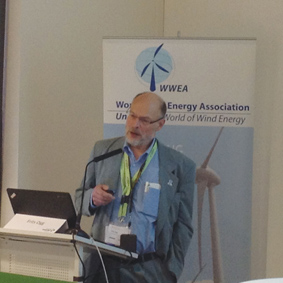 Wind turbines are connected to a grid that transports electricity, heat, water or gas in one way or another. During recent years a lot of grids with ‘marketing’ names such as ECOgrid, Intergrid or Supergrid have showed up. What's in a name? and what does the name mean? How can we communicate if we don't know what the difference is between a microgrid and an ECOgrid and what the role of wind turbines is in a specific electricity grid?
Wind turbines are connected to a grid that transports electricity, heat, water or gas in one way or another. During recent years a lot of grids with ‘marketing’ names such as ECOgrid, Intergrid or Supergrid have showed up. What's in a name? and what does the name mean? How can we communicate if we don't know what the difference is between a microgrid and an ECOgrid and what the role of wind turbines is in a specific electricity grid?
Frits Ogg, Renewable Energy Consultant, The Netherlands
Over the last few years several organisations have studied the taxonomy of electricity grids. As a researcher one likes to have a clear definition; however, the marketeer on the other hand likes to create his or her own commercial definition.
Offshore wind turbines may be connected to a supergrid (www.friendsofthesupergrid.eu/). If we are more specific and define our grids with preferred SI prefixes the supergrid should perhaps be called a gigagrid and gigagrids could be characterised by always having higher voltages.
Following the path of SI prefixes, grids could be universally called attogrids, picogrids, microgrids, milligrids, grids, megagrids and gigagrids. These would primarily be defined by their function(s), and their different characteristics such as high/low voltage, DC, AC or DC/AC, storage, off-grid/part of a greater grid, etc.
As seen at many international wind congresses a lot of the research on wind focuses on the development of cheaper wind energy and thus larger wind turbines. However, for logistical and technical reasons megawatt wind turbines are useless at many onshore sites and a great part of the Earth’s surface still needs affordable and reliable smart small and medium wind turbines. So wind turbines will not only be around in megagrids but also in microgrids and picogrids.
Even very small 10W wind turbines like the ones in the Unavco Antarctic project are part of a picogrid and characteristics of a picogrid could be that it has low voltage DC, its own renewable energy source(s), storage and consumer(s) and, of course, energy management.
The need for classification arose especially for the development of small electricity grids with AC, DC and AC/DC, such as home microgrids. Research on this has been carried out among others by Berkeley National Laboratory (Bruce Nordman et Al). It is important to note that small grids can be part of bigger grids, and, for example, a picogrid can be part of a microgrid. Recently the state of New York divided its megagrid into microgrids. These microgrids should function on their own in the case of a disaster like Hurricane Sandy to prevent long total outages. Small and medium wind turbines have a part to play in these microgrids in the future.
And, Yes, every grid can be ‘smart’, or indeed must be smart or at least prepared to be smart, as also the turbines have to be smart, but that's another story.










